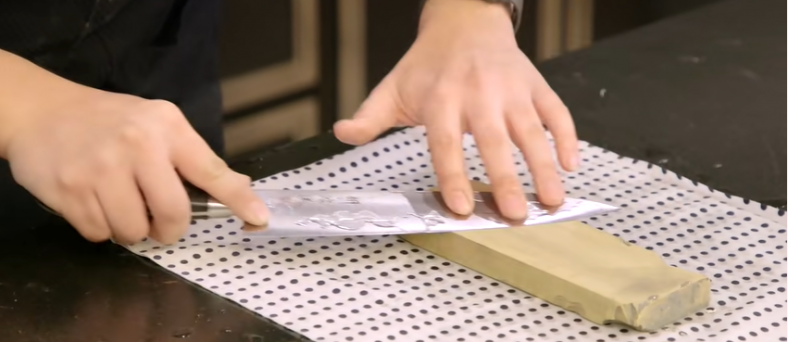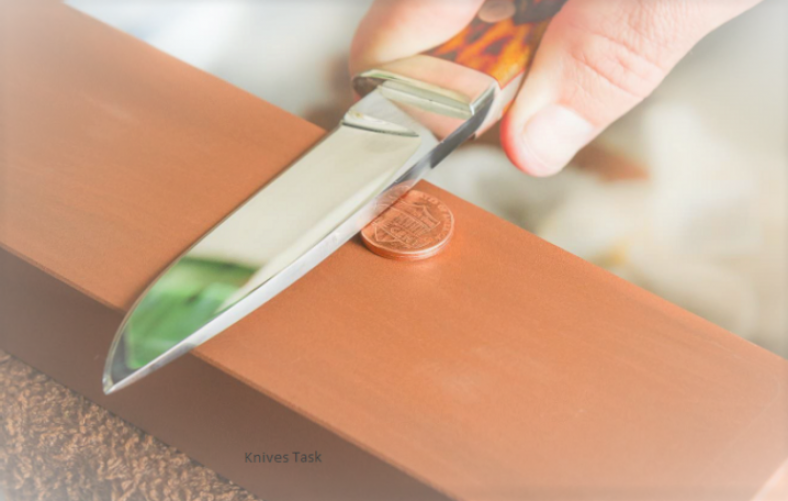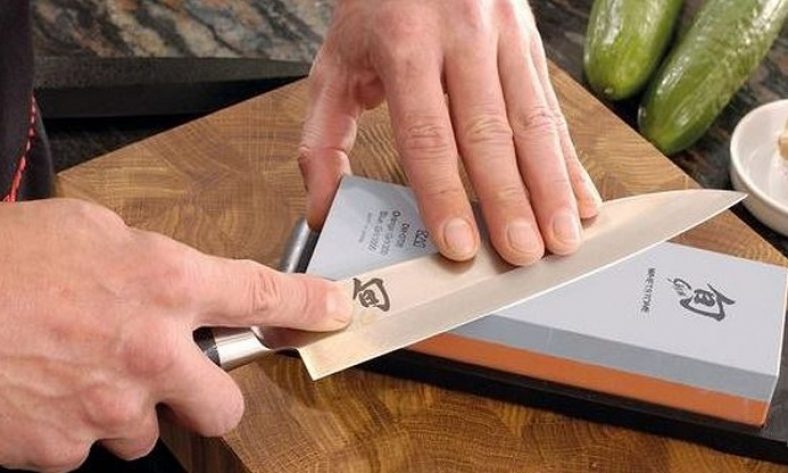Santoku knife is generally a multipurpose knife that can be used to cut and chop vegetables, meat, and fish. It can slice, dice, and chop at the same time. Due to the versatility it provides to the user, it is one of the most used knives by professional chefs. The flat and robust blade provides maximum contact with the surface, providing precise cutting of the ingredients. Since the knife can be used for various purposes, it is essential to keep the blade sharp and clean.
This article will help the users to know how to sharpen a santoku knife and tools required for the same. Since the module is single bevel and constructed from the harder steel, it is easier to create a finer edge and angle on this knife. These knives are generally sharpened at an angle between 10-15 degrees.
Using a Whetstone to sharpen the knife
Since these knives do not have a bolster, they are much easier to sharpen and require less time than other blades. Made from the harder steel, the best way of sharpening this knife is with the help of a whetstone. Whetstone is a fine-grained stone that is used for sharpening cutting tools like a knife. They are made from artificial stones that are mostly made of ceramic, such as silicon carbide or aluminum oxide.
Whetstones use a process abrasion, which removes any uneven surface on blades when brought in contact. Using a Whetstone requires proper and careful procedures, giving you the best quality edge for the blade. The technique is most commonly used by professional chefs to get long-lasting sharpness. Let’s have a look at the steps that need to be followed for a knife to happen through a whetstone.
- First, we need to submerge the whetstone in water for at least 15-20 minutes, unless one does not see any air bubbles emerge. It allows the surface of a whetstone to be wet and lubricated, to make sure it does not have any dry roughness which could damage the knife.
- After being submerged for 15-20 minutes, put the stone on a damp cloth to ensure that it does not move while in use. Now using the coarse side first, tilt the knife at an angle of 10-15 degrees and run the blade up and down on the stone in a smooth motion.
- Make sure to cover the entire blade from the bottom to the edge. Run the blade on one side for 10-15 minutes to get maximum sharpness. If you have a double-beveled knife, repeat the same process on the other side of the blade. Once done, flip the whetstone on the finer side and repeat the process for the finish.
- Once the process is completed, wash the knife with warm water and clean it with a dry cloth. Leaving any moisture on the blade can lead to conditions preferable for rust.
Depending on the type of knife, there are different types of whetstones available in the market. Fiber to higher grits, one can select depending on their experience of using it. Professionals tend to use whetstones with higher grits; meanwhile, whetstones with fewer grits are preferable for beginners. While purchasing a whetstone, make sure you select one made of ceramic material, as they are more durable and provide much better sharpness than others.
Using a Honing steel
It is the second most preferred knife sharpening techniques that are used by professional and global chefs. Honing steel is a sharpening tool for a knife that can be easily found in online and offline markets. Using it is much easier and faster than a whetstone and can also be used by a beginner. A honing steel is a long vertical rod made up of durable stainless steel.
Honing steel pushes the edge of the knife back to the center and straightens it. The best part about using honing steel is that it does not shave a lot of steel to correct its edge, not the case in a whetstone. It helps to process and shave the bits on the knife and make it much smoother.
- Using the honing steel is very easy. Hold the honing steel vertically on a board that has been placed under a damp cloth to avoid any movement.
- While the honing steel has been placed vertically, we will have to start from the top.
- Place the heel of the blade on the top of the vertically placed honing steel.
- Now drag the knife at a 10-15 degree angle. While you move downwards towards the honing steel, make sure to pull the knife towards yourself. When you read the end, the bottom of the honing steel will be in contact with the blade’s edge.
- Repeat the same process for 5-10 minutes each side of the blade if it is double beveled. Once done, the knife will be as sharp as new.
If you use the knife daily, it would be best to opt for honing steel made of ceramic or has a diamond coating, which makes it harder than steel. Honing steel is not only used to sharpen the blade but also to restore the bent edge. It is the primary reason why it is used as it can help to straighten a blade quickly.
Other ways of sharpening knife
These are the primary ways to sharpen their knife, to make sure that they have a long-lasting and finer edge. However, one can also opt to go for a knife sharpening manual or an electric machine, which can also do the job. Also, some knife companies provide a lifetime warranty where you can send them the knife through the post, and they will do it for free. The only cost one has to bear is the postal return fee. However, it does take a few days for one to send and receive the blade.
Also, help you this video sharpen a santoku knife
Conclusion
These are some of the techniques and methods that can be used to sharpen a Santoku knife. Since santoku knives have a flat blade and are made up of harder steel, using a whetstone should be the primary choice for users to sharpen it.
Using a lower grit whetstone for beginners and higher grit whetstone for professionals will do the trick. If you are looking for professional quality sharpness and finesse from your knife, then whetstones and going steel should be the one to go for. If you are looking for something more manageable, then try using an automatic knife happening tool.








